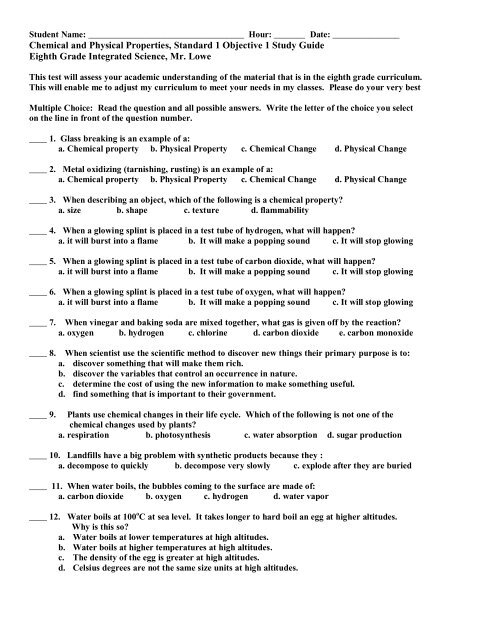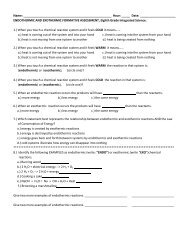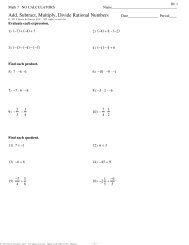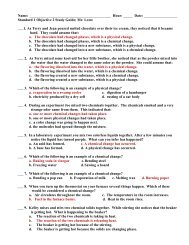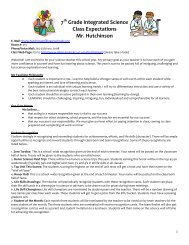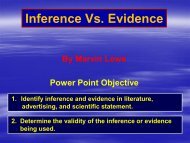Chemical And Physical Properties - Mount Logan Middle School
Chemical And Physical Properties - Mount Logan Middle School
Chemical And Physical Properties - Mount Logan Middle School
You also want an ePaper? Increase the reach of your titles
YUMPU automatically turns print PDFs into web optimized ePapers that Google loves.
Student Name: ___________________________________ Hour: _______ Date: _______________<br />
<strong>Chemical</strong> and <strong>Physical</strong> <strong>Properties</strong>, Standard 1 Objective 1 Study Guide<br />
Eighth Grade Integrated Science, Mr. Lowe<br />
This test will assess your academic understanding of the material that is in the eighth grade curriculum.<br />
This will enable me to adjust my curriculum to meet your needs in my classes. Please do your very best<br />
Multiple Choice: Read the question and all possible answers. Write the letter of the choice you select<br />
on the line in front of the question number.<br />
____ 1. Glass breaking is an example of a:<br />
a. <strong>Chemical</strong> property b. <strong>Physical</strong> Property c. <strong>Chemical</strong> Change d. <strong>Physical</strong> Change<br />
____ 2. Metal oxidizing (tarnishing, rusting) is an example of a:<br />
a. <strong>Chemical</strong> property b. <strong>Physical</strong> Property c. <strong>Chemical</strong> Change d. <strong>Physical</strong> Change<br />
____ 3. When describing an object, which of the following is a chemical property?<br />
a. size b. shape c. texture d. flammability<br />
____ 4. When a glowing splint is placed in a test tube of hydrogen, what will happen?<br />
a. it will burst into a flame b. It will make a popping sound c. It will stop glowing<br />
____ 5. When a glowing splint is placed in a test tube of carbon dioxide, what will happen?<br />
a. it will burst into a flame b. It will make a popping sound c. It will stop glowing<br />
____ 6. When a glowing splint is placed in a test tube of oxygen, what will happen?<br />
a. it will burst into a flame b. It will make a popping sound c. It will stop glowing<br />
____ 7. When vinegar and baking soda are mixed together, what gas is given off by the reaction?<br />
a. oxygen b. hydrogen c. chlorine d. carbon dioxide e. carbon monoxide<br />
____ 8. When scientist use the scientific method to discover new things their primary purpose is to:<br />
a. discover something that will make them rich.<br />
b. discover the variables that control an occurrence in nature.<br />
c. determine the cost of using the new information to make something useful.<br />
d. find something that is important to their government.<br />
____ 9.<br />
Plants use chemical changes in their life cycle. Which of the following is not one of the<br />
chemical changes used by plants?<br />
a. respiration b. photosynthesis c. water absorption d. sugar production<br />
____ 10. Landfills have a big problem with synthetic products because they :<br />
a. decompose to quickly b. decompose very slowly c. explode after they are buried<br />
____ 11. When water boils, the bubbles coming to the surface are made of:<br />
a. carbon dioxide b. oxygen c. hydrogen d. water vapor<br />
____ 12. Water boils at 100 o C at sea level. It takes longer to hard boil an egg at higher altitudes.<br />
Why is this so?<br />
a. Water boils at lower temperatures at high altitudes.<br />
b. Water boils at higher temperatures at high altitudes.<br />
c. The density of the egg is greater at high altitudes.<br />
d. Celsius degrees are not the same size units at high altitudes.
Use this graph to answer questions 13 – 16.<br />
Phase Change for Water at Sea Level<br />
120<br />
100<br />
Temperature in degrees Celsius<br />
80<br />
60<br />
40<br />
20<br />
0<br />
-20<br />
0 1 2 3 4 5 6 7 8 9 10 11 12 13 14 15 16 17 18 19 20<br />
Water Temp. -6 -3 0 0 0 3 8 14 22 32 50 62 72 80 86 92 96 98 100 100 100<br />
Time in Minutes<br />
Water Temp.<br />
____ 13. What is happening from minute 2 – minute 4?<br />
a. The temperature stays the same during phase change from ice to water.<br />
b. The temperature is rising between phase changes.<br />
c. The temperature stays the same during phase change from water to water vapor.<br />
d. The thermometer is probably broken.<br />
____ 14. All of the ice is turned to water by the end of minute:<br />
a. 2 b. 3 c. 4 d. 5 e. 20<br />
____ 15. During phase change as temperature stays constant the heat energy in the water:<br />
a. increases b. decreases c. stays the same<br />
____ 16. From the end of minute 4 to the beginning of minute 18 all of the water was in ______ phase.<br />
a. solid b. liquid c. Gas d. plasma<br />
____ 17. Which of the following will not cause a change in the temperature at which water boils?<br />
a. increase or decrease of latitude c. increase or decrease of atmospheric pressure<br />
b. increase or decrease of altitude
Use the following chart to answer questions 18 – 21.<br />
Flask<br />
Dissolution Rate of 1 Cubic Centimeter of Sugar<br />
in 150 ml of water<br />
Procedure<br />
Complete Dissolution Time,<br />
(Seconds)<br />
Trial 1 Trial 2 Trial 3 Average<br />
1 Sugar in water undisturbed 15.95 15.78 16.01 15.91<br />
2<br />
Sugar ground and placed in<br />
undisturbed water<br />
10.64 10.82 10.53 10.66<br />
3<br />
Sugar ground, placed in water and<br />
swirled<br />
1.78 1.82 1.86 1.82<br />
4<br />
Sugar ground, placed in water, swirled,<br />
and heated<br />
.42 .40 .52 .45<br />
____ 18. What was the most effective set of steps for dissolving sugar?<br />
a. flask 1 b. flask 2 c. flask 3 d. flask 4<br />
____ 19. What action had the greatest effect on dissolution rate of sugar?<br />
a. sugar cube in water b. grinding the sugar c. swirling the sugar d. heating the sugar<br />
____ 20. Which action had the least effect on dissolution rate of sugar?<br />
a. flask 1 b. flask 2 c. flask 3 d. flask 4<br />
____ 21. What effects the validity of the data in this experiment most?<br />
a. organization of the chart b. multiple trials for each flask c. presentation on a chart<br />
A student designed an experiment to test the chemical and physical properties of four known, solid<br />
substances (A, B, C, and D) and one unknown solid substance. She suspected the unknown substance<br />
was one of the four known substances. The properties she considered testing are listed below.<br />
boiling point melting point freezing point density mass volume shape<br />
reaction to acid reaction to base reaction to water reaction to heat color odor<br />
____ 22.The student discovered that the unknown was identical to substance “C” in every property<br />
except mass and volume. Could the unknown possibly be identified as “C”?<br />
a. yes, if any of properties are the same, then the substances are the same<br />
b. yes, mass and volume vary even in the same substance<br />
c. no, mass and volume are important measurements<br />
d. no, all properties must match<br />
____ 23. Study the list of processes that can bring about chemical and physical changes below.<br />
1. Cooking oil was splashed on a hot stove burner.<br />
2. Electricity was run through water to separate the hydrogen from the oxygen.<br />
3. A shovel was left stuck in the mud over the winter.<br />
4. Baking soda and hot water were used to clean the corrosion off a car battery.<br />
5. A magnifying glass focused the sun’s rays to there brightest point on paper.
6. A bicycle chain was left out in the rain without any oil.<br />
a. 5, 6 b. 2, 5 c. 1, 4 d. 3, 6<br />
____ 24. What is 25 degrees Celsius in degrees Kelvin?<br />
a. 298 b. 248 c. 398 d. 348 e. 237<br />
____ 25. What is 200 degrees Kelvin in degrees Celsius?<br />
a. 300 b. -100 c. 73 d. -73 e. 12<br />
____ 26. Both hydrogen and oxygen are flammable. Water is made of 2 parts hydrogen and 1 part<br />
oxygen, why doesn’t water burn?<br />
a. Water will burn if you get it hot enough.<br />
b. Because water is a liquid and hydrogen and oxygen are gases.<br />
c. When elements combine physically they form new substances with different properties.<br />
d. When elements combine chemically they form new substances with different properties.<br />
____ 27. What is the measurement of the liquid above?<br />
a. 10 milliliters b. 12 grams c. 11.5 milliliters d. 11.5 grams<br />
____ 28. Which of the following is not a chemical property of matter?<br />
a. flammability b. corrosive c. melting point d. acid/base reactivity<br />
____ 29. Which of the following is true of chemical properties?<br />
a. They describe the phase the substance is in.<br />
b. They describe characteristics of a substance such as size, color, and shape.<br />
c. They explain how the substance reacts with other substances.<br />
d. They describe what chemical changes the substance is currently going through.<br />
While investigating the chemical and physical properties of a new substance created in class,<br />
Sally and Tyler record the following observations: (Use to answer question 30.)<br />
The new substance is solid.<br />
The new substance forms into thin flat sheets.<br />
The new substance is smooth.<br />
The new substance will burn.<br />
The new substance looks like it will tear easily.<br />
The new substance looks like it will dissolve in acid easily.<br />
____ 30. Which of their statements would be an inference about a chemical property?
a. The new substance forms into thin flat sheets.<br />
b. The new substance is smooth.<br />
c. The new substance looks like it will tear easily.<br />
d. The new substance looks like it will dissolve in acid easily.<br />
____ 31. A scientist places 10 mL of water in a test tube and heats the liquid over a Bunsen burner<br />
for 2 minutes. The liquid boils and escapes as steam. This experiment is a good example of<br />
a. chemical change involving phase changes c. chemical change involving chemical reactions<br />
b. physical change involving phase changes d. physical change involving chemical reactions<br />
____ 32. What is one way that a plastic soda bottle is better than a glass one?<br />
a. It is transparent c. It is recyclable<br />
b. It doesn’t flavor the drink d. It doesn’t shatter<br />
Answer questions 33 – 41 with the following choices. One answer will be used more than once.<br />
a. 0 b. 373 c. 100 d. 212 e. 273 f. -273 g. 32 h. – 460<br />
____ 33. Absolute Cold Kelvin ____ 36. Freezing Kelvin ____ 39. Boiling Kelvin<br />
____ 34. Absolute Cold Celsius ____ 37. Freezing Celsius ____ 40. Boiling Celsius<br />
____ 35. Absolute Cold Fahrenheit ____ 38. Freezing Fahrenheit ____ 41. Boiling Fahrenheit<br />
A cube of sugar has the following properties. Mark each property as a (C)chemical or<br />
(P)physical property. (42 – 46)<br />
____ 42. Mass = 2 grams<br />
____ 43. Density = 8 g/cm 3<br />
____ 44. Burns when heated<br />
____ 45. Composed of small, white crystals<br />
____ 46. Bubbles and fizzes when heated<br />
Terry and Jean experimented with several items to see what would happen under different<br />
conditions. Below is the data table they wrote at the conclusion of the experiment.<br />
Put in water over<br />
night<br />
Held in candle flame<br />
for 30 seconds<br />
Connected to the terminals<br />
of a 12 volt battery<br />
Steel wool Rusted Burned Burned<br />
Paper Got soppy Burned No change<br />
Copper wire Got wet Got hot, bent in the Got hot, melted in half<br />
middle<br />
Wood<br />
splinter<br />
Swelled up with water Burned<br />
No change<br />
____ 47. Which substance changed chemically under all three conditions?<br />
a. steel wool b. paper c. copper wire d. wood splinter
____ 48. Which substance changed physically under all three conditions?<br />
a. steel wool b. paper c. copper wire d. wood splinter<br />
____ 49. What would be a good conclusion for this experiment?<br />
a. Steel wool is the most reactive.<br />
b. Paper is the most reactive.<br />
c. Copper wire is the most reactive.<br />
d. Wood splinter is the most reactive.<br />
Study the list of potential chemical and physical changes below. Then answer the questions (50 – 52).<br />
A. Jim uses baking soda and vinegar to make bubbles to erupt a model volcano.<br />
B. Fred left a sack of steel nails out on the porch where they got wet and rusted.<br />
C. Jack scraped flint across steel to light his cigarette lighter.<br />
D. The door panel of Jan’s old truck has the paint scraped off and is rusted.<br />
E. Jane strikes a sulfur match rapidly across a hard surface to light it.<br />
F. Jill uses baking powder in her biscuits to cause bubbles to form in the cooking dough.<br />
____ 50. What are the changes described above?<br />
a. <strong>Physical</strong> changes of size, shape, and color<br />
b. <strong>Physical</strong> changes of phase, volume, and density<br />
c. <strong>Chemical</strong> changes of respiration, pH, and Photosynthesis<br />
d. <strong>Chemical</strong> changes of rusting, burning and gas production<br />
____ 51. What would indicate that burning might take place in some of these chemical reactions?<br />
a. wet metal in air b. bubbles in air c. heat generated d. energy is absorbed<br />
____ 52. What conditions would indicate rusting might take place in some of these chemical reactions?<br />
a. wet metal in air b. bubbles in air c. heat generated d. energy is absorbed<br />
The following data was collected by a group of students as they tested four different types of plastics.<br />
(Use the information to answer questions 53 – 56.)<br />
Plastic Acetone Flame test Heat Crease color<br />
1 No effect Green color Softens None<br />
2 Softened No change No change White<br />
3 No effect Red color Softens None<br />
4 No effect Green color Softens None<br />
____ 53. Which of the plastics might be the same?<br />
a. 1 & 2 b. 2 & 3 c. 3 & 4 d. 1 & 4<br />
____ 54. Which plastic would be best to put in a microwave?<br />
a. 1 b. 2 c. 3 d. 4<br />
____ 55. Which plastic could be used with a flame?<br />
a. 1 b. 2 c. 3 d. 4
____ 56. Which plastic would be unsafe to use to store products that contain acetone?<br />
a. 1 b. 2 c. 3 d. 4<br />
Study the list of processes that can bring about chemical and physical changes.<br />
(Use the following information to answer questions 57 - 59.)<br />
A. Cooking oil was splashed on a hot stove burner.<br />
B. Electricity was run through water to separate the hydrogen from the oxygen (Electrolysis).<br />
C. A shovel was left stuck in the mud over the winter.<br />
D. Baking soda and hot water were used to clean the corrosion off a car battery’s terminals.<br />
E. A magnifying glass focused the sun’s rays to their brightest point on a piece of paper.<br />
F. A bicycle chain was left out in the rain without any oil.<br />
____ 57. Which items on the list would most likely deal with rusting?<br />
a. F, E b. B, E c. A, D d. C, F<br />
____ 58. Which items on this list would most likely give off gas?<br />
a. B, D b. A, E c. B, F d. C, F<br />
____ 59. Which items on the list would most likely burn?<br />
a. A, E b. F, C c. B, D d. A, F<br />
Examine the following table to answer questions 60 – 63.<br />
Substance<br />
Sugar<br />
Salt<br />
Baking<br />
Soda<br />
Flour<br />
Sodium<br />
<strong>Physical</strong><br />
Description<br />
Small, white,<br />
hard crystals<br />
Small, white,<br />
hard crystals<br />
Fine, white,<br />
smooth powder<br />
Fine, white,<br />
smooth powder<br />
Soft silver white<br />
Family 1 metal<br />
Reaction to<br />
Acid (weak<br />
HCl solution)<br />
Reaction to Water Reaction to Heat<br />
None None Caramelizes (turns<br />
brown and bubbly)<br />
None None None<br />
Bubbles and<br />
fizzes<br />
None<br />
None<br />
None None Turns brown, if blown<br />
into a flame it will burn.<br />
None Moves around in the water<br />
None<br />
giving off Hydrogen gas.<br />
____ 60. Which substance would be considered the most reactive with acid?<br />
a. sugar b. salt c. baking soda d. flour e. Sodium<br />
____ 61. Which of these tests measured chemical properties?<br />
a. physical description and reaction to heat c. reaction to water and physical description.<br />
b. physical description and reaction to acid d. reaction to acid, water, heat<br />
____ 62. Which substance would be most reactive with water?<br />
a. sugar b. salt c. baking soda d. flour e. Sodium<br />
____ 63. Which of the above substances is least chemically reactive?
a. sugar b. salt c. baking soda d. flour e. Sodium


